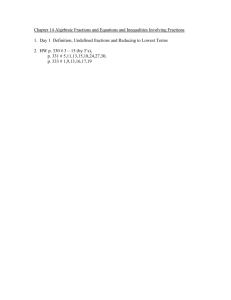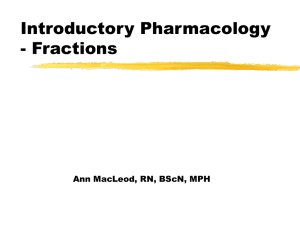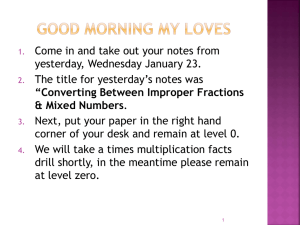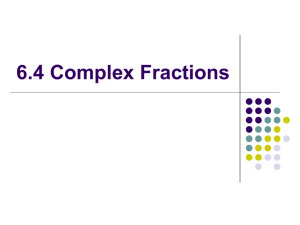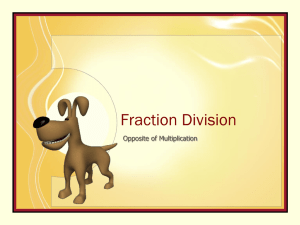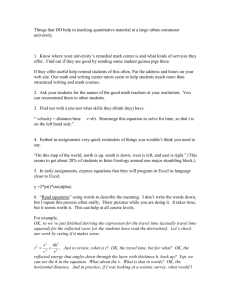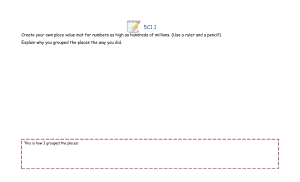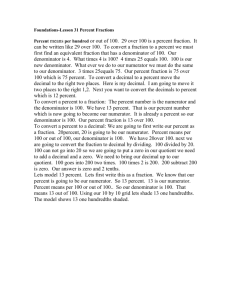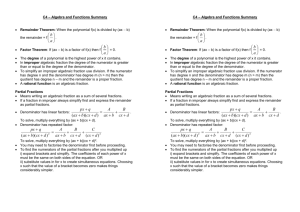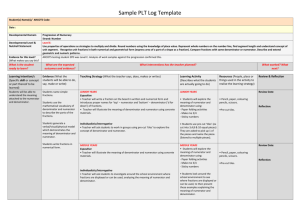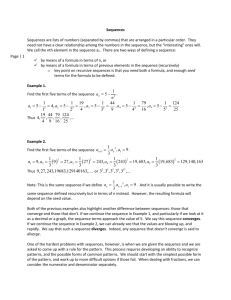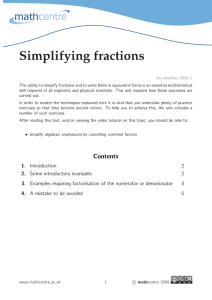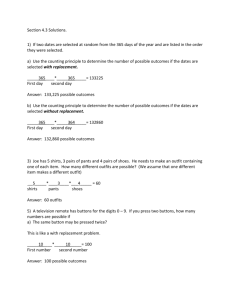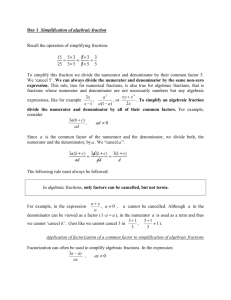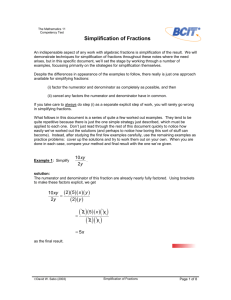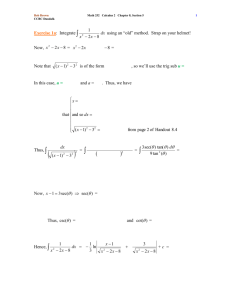Algebraic Fractions Answers
advertisement
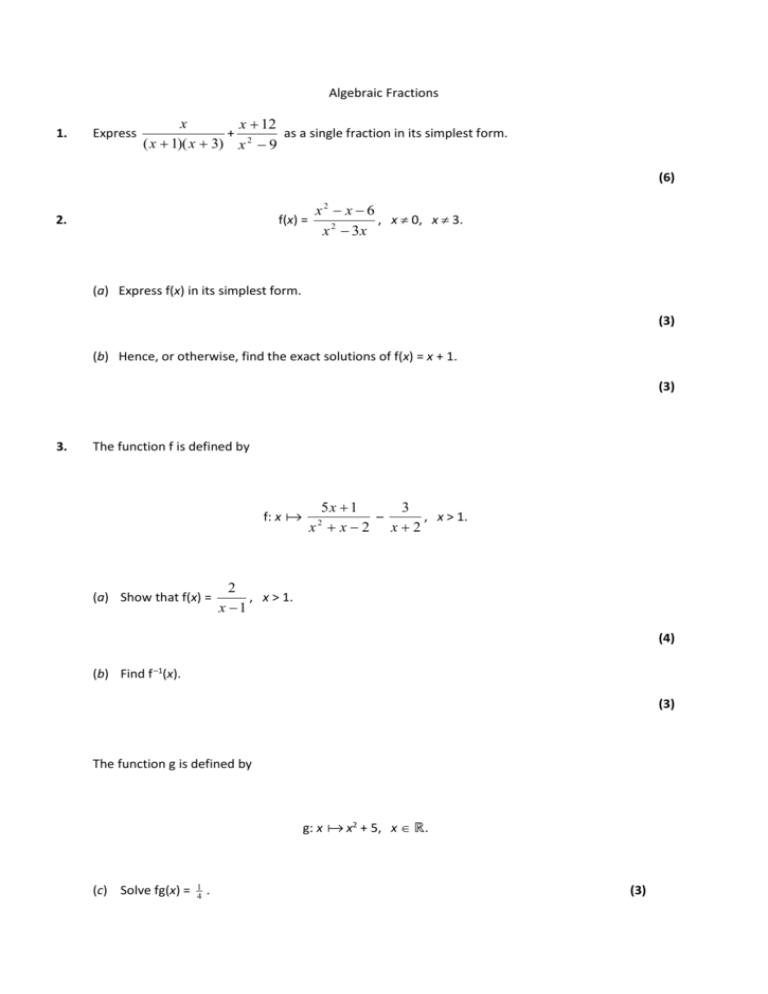
Algebraic Fractions 1. Express x x 12 + 2 as a single fraction in its simplest form. ( x 1)( x 3) x 9 (6) 2. f(x) = x2 x 6 , x 0, x 3. x 2 3x (a) Express f(x) in its simplest form. (3) (b) Hence, or otherwise, find the exact solutions of f(x) = x + 1. (3) 3. The function f is defined by f: x (a) Show that f(x) = 5x 1 3 – , x > 1. x x2 x2 2 2 , x > 1. x 1 (4) (b) Find f –1(x). (3) The function g is defined by g: x x2 + 5, x ℝ. (c) Solve fg(x) = 1 4 . (3) 4. Express 6 2 x 2 3x – 2 (2 x 3)( x 2) x x 2 as a single fraction in its simplest form. (7) 5. (a) Simplify 3x 2 x 2 . x2 1 (3) (b) Hence, or otherwise, express 3x 2 x 2 1 – as a single fraction in its simplest form. 2 x( x 1) x 1 (3) 6. really (cant edit the number!) 7. Given that: f ( x) 2x 3 9 2x 2 x 2 2 x 3x 2 Show that f ( x) 4x 6 2x 1 7 Marks 8. Given that: 2 x 4 3x 2 x 1 dx e ax 2 bx c 2 2 x 1 x 1 find the values of the constants a, b, c, d , e. Algebraic Fractions Answers Question Scheme Marks number x2 – 9 = (x – 3)(x + 3) seen 1. B1 Attempt at forming single fraction M1; A1 x( x 3) ( x 12)( x 1) 2 x 2 10 x 12 ;= ( x 1)( x 3)( x 3) ( x 1)( x 3)( x 3) Factorising numerator = 2( x 2)( x 3) 2( x 2 ) or equivalent = ( x 1)( x 3)( x 3) ( x 1)( x 3) M1 M1 A1 (6) (6 marks) ( x 3)( x 2) ( x 2) 2 ; or 1 x( x 3) x x 2a) B1 numerator, B1 denominator ; B1 either form of answer B1,B1,B1 M1 for equating f(x) to x + 1 and forming quadratic. (3) A1 candidate’s correct quadratic ( x 2) x 1 x2 2 x M1 A1√ 2b) 3 (a) x 2 A1 5x 1 3 ( x 2)( x 1) x 2 B1 5 x 1 3( x 1) ( x 2)( x 1) = M1 M1 for combining fractions even if the denominator is not lowest common 2x 4 ( x 2)( x 1) = = M1 A1 cso 2( x 2) 2 ( x 2)( x 1) = x 1 * (4) M1 must have linear numerator (b) 2 x 1 y= M1A1 xy y 2 xy = 2 + y A1 2 x f –1(x) = x 2 x 4 fg(x) = (3) o.e. 2 (attempt) 2 2 x 4 = Setting 2 " g" 1 ] [ 1 4 and finding x2 = …; M1 M1; A1 x= 2 (3) [10] Question Scheme Marks Number x2 x 2 x 2 x 1 4. At any B1 stage x 2 x 3 2 x 2 3x x 2 x 3 x 2 2 x 3 x 2 x 2 B1 x x 1 6 2 x 2 3x 6 2 2 x 3 x 2 x x 2 x 2 x 1 M1 x2 x 6 x 2 x 1 A1 x 3 x 2 x 2 x 1 M1 A1 x3 x 1 A1 (7) [7] Alternative method x2 x 2 x 2 x 1 At any B1 stage 2 x 3 appearing as a factor of the numerator at any stage 2 x 2 3x x 1 6 2 x 3 2 x 2 3x 6 2 x 3 x 2 x 2 x 1 2 x 3 x 2 x 1 2 x3 5 x 2 9 x 18 2 x 3 x 2 x 1 B1 M1 can be A1 implied M1 x 2 2x2 9x 9 2 x 3 x 2 x 1 or 2 x 3 x 2 x 6 2 x 3 x 2 x 1 or x 3 2 x 2 x 6 2 x 3 x 2 x 1 Any one linear factor × quadratic 2 x 3 x 2 x 3 2 x 3 x 2 x 1 x3 x 1 Complete A1 factors Question number 5. (a) A1 (7) Scheme 3x 2x 1 , x 1x 1 3x 2 x 1 Marks M1B1, A1 (3) Notes M1 attempt to factorise numerator, usual rules B1 factorising denominator seen anywhere in (a), A1 given answer If factorisation of denom. not seen, correct answer implies B1 (b) Expressing over common denominator 3x 2 1 x3x 2 1 x 1 x x 1 x x 1 (3x 2 x 2) x ( x 1) [Or “Otherwise” : ] x( x 2 1) M1 Multiplying out numerator and attempt to factorise 3x 2 M1 2 x 1 3x 1x 1 Answer: 3x 1 x A1 (3) Total 6 marks



